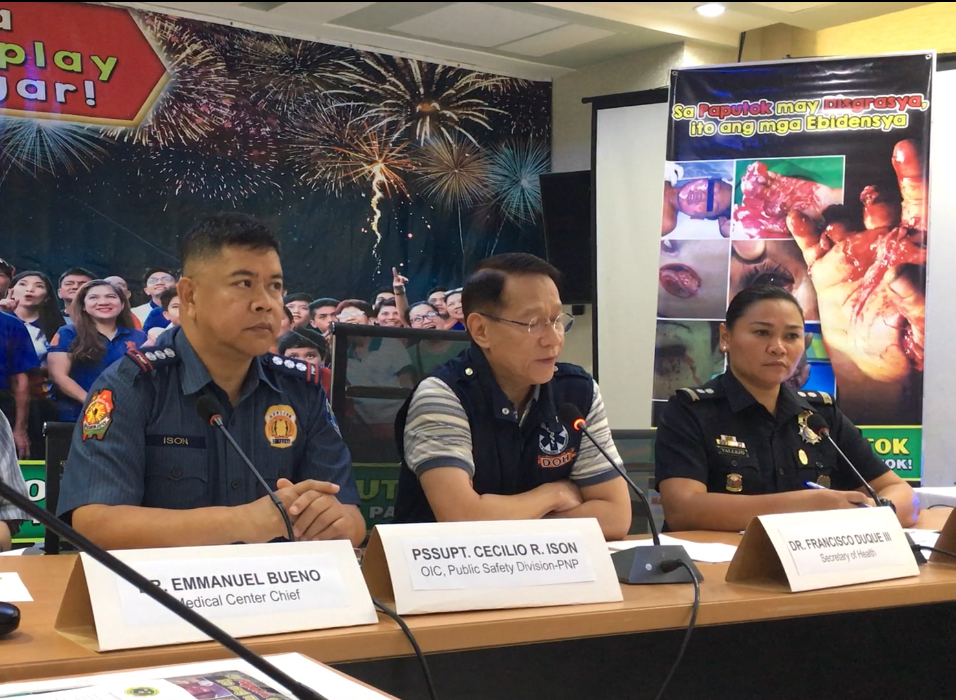By Ma. Teresa Montemayor/PNA

MANILA — Health Secretary Francisco Duque III said on Monday there had been a significant drop in the number of fireworks-related injuries (FWRIs) this year compared to last year.
“We are happy to see a 68 percent decline in the number of cases, but we also expect cases to increase as there are still late reports coming from other regions. Additional cases may come from children picking up unexploded fireworks on the streets, so we remind parents to be on the lookout for their children’s safety,” he said in a press briefing at the East Avenue Medical Center in Quezon City.
Duque said the 139 FWRIs this year is much lower compared to the 289 cases last year.
The FWRIs were recorded by 60 sentinel hospitals from Dec. 21, 2018 to 6 a.m. of Jan. 1, 2019. Two of the total cases included fireworks ingestion. There were no cases of death and stray bullets.
The FWRIs mostly involved males aged between two and 69 years old and 64 percent of them are active users of fireworks while the rest are passive users.
A total of 102 cases suffered from blast or burn without amputation, while five suffered from blasts resulting in amputation. The remaining 36 cases suffered eye injuries.
Senior Supt. Cecilio Ison, Philippine National Police (PNP) Public Safety Division officer-in-charge, said the increase in the number of eye injuries could be related to the increase of “Boga” users in lieu of piccolo.
“Ito po iyong gawa sa PVC pipe o lata ng softdrinks na pinagdugtong tapos nilalagyan ng denatured alcohol tapos sinisindihan. Maaring magkaroon ng injury dahil sa back blast, kasi kapag may mga batang naglalaro nito ang nasa likod nila puwede matamaan (This is made from PVC pipe or connected soda cans filled with denatured alcohol then lit up. There could be injuries due to back blast, if there’s a child playing with this the one at his back could be hit),” he said.
The fireworks which caused the most injuries are Kwitis with 30 cases, Boga with 16 cases, Piccolo with 15 cases, Luces with eight cases, and Five Star and Triangle with seven cases each.
The regions with the most number of cases include the National Capital Region with 53 cases, Western Visayas with 26 cases, Central Visayas with 13 cases, and Central Luzon and Calabarzon (Cavite, Laguna, Batangas, Rizal, and Quezon) with 10 cases each.
A total of 73 cases happened on the streets; 59 took place at home; five occurred in other places, while the remaining two happened in the designated fireworks display area.
Duque said the FWRIs in the designated fireworks display area could have been caused by incorrect management of fireworks display.
“Baka hindi miyembro ng kapulisan ang nagsindi ng paputok. Baka hindi (The fireworks could have been lit not by the policemen. They could have not been) trained… I’m just theorizing but this warrants the investigation of our field epidemiologist,” he added.
Citing his earlier experience as a Department of Health (DOH) secretary, Duque said this year’s FWRI statistics is the historic low in the many years of surveillance done by the DOH every New Year’s Eve.
“This is because of that executive order the substantive downward in the FWRIs began, because of which there was a 27 percent decline last year compared to the year before it. Nature this time took the side of DOH as it has been raining in the past days,” he said.
Under Executive Order No. 28, the use of firecrackers shall be confined to community fireworks display areas to minimize the risk of injuries and casualties.
